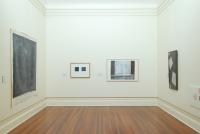Hibernation: Winter works from the collection
When it is grey, cold, dark and damp nothing seems more attractive than staying inside, keeping warm and hibernating. Like bears denning for the winter, we humans often withdraw – into houses, our thick coats and ourselves. This exhibition explores the feeling, colour and idea of winter.
Winter is a rich source of material and metaphor used often in art and literature. Poets and writers such as William Shakespeare, Emily Dickinson, William Blake and Robert Frost have all used winter in their work to express death, pain, melancholy, loneliness and endings. In the visual arts these themes are similarly entiwned. We imagine winter as desolate and colourless and in Gate 16 Colin McCahon used his signature black and white composition to explore winter as the end of all things – nuclear war and nuclear winter. Several of the extended labels in this exhibition use quotes from poems, songs, plays and books to further exemplify the place winter has in the arts as a source of inspiration.
Winter can be very sad, but if we take the time to emerge from hibernation we can see it is also a time of great splendour. Michael Smither’s Mount Egmont and William Barraud’s Dawn on Aorangi show us the beauty of a New Zealand winter. The mountains are clothed in the pristine white blanket of snow which makes the landscapes of New Zealand so entrancing during the winter months. The light here is unique and during the short winter days light plays an important role in how we experience the world. In his Winter Solstice/Spring Equinox ’83 series John Bailey explores the movement of light, while Ralph Hotere in June, July and August also works with light and colour through the passage of time. Colour is incredibly emotive and each carries meaning and connotations – yellow is the sun, blue the sky and red is danger. The colours we associate with winter are those which dominate this exhibition – black, white, grey and a splash of icy blue. In these colours we see the long dark nights, snow covered mountains, cloudy skies and icy mornings of winter.
The paintings and prints in this exhibition spend much of their life tucked away from harsh light and extreme temperatures to ensure they are safe. They live in their own state of hibernation until they are put on public display.
Text extracted from the Sarjeant Gallery Te Whare o Rehua website.



